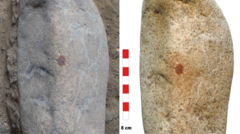Scientists excavating in Spain have made an incredible discovery that might change how we view Neanderthals! They found the oldest full human fingerprint on a rock that looks like a face. It’s believed a Neanderthal used red pigment about 43,000 years ago to paint a nose on this pebble.
The site, called the San Lázaro rock shelter in Segovia, revealed the stone buried under 1.5 meters of sediment from Neanderthal habitation. Prof. María de Andrés-Herrero from the University of Complutense explained the significance: because of the way the dot is positioned, it suggests Neanderthals had some form of "symbolic behavior"—indicating they could think abstractly.
The team confirmed that the reddish dot was made using ochre, a natural clay pigment, and they even identified a male adult fingerprint. However, co-author David Álvarez Alonso mentioned it's challenging to make definite comparisons due to the lack of other Neanderthal prints.
Spanish official Gonzalo Santonja stated that this pebble is not only the oldest painted portable object in Europe but also the only known Neanderthal-painted art piece. Researchers believe the rock was brought intentionally to the shelter because the red pigment isn't naturally found there, hinting at Neanderthals being capable of artistic expression.
In their scientific report, the team expressed pride in presenting what could be one of the earliest examples of portable art known to date, challenging previously held views about Neanderthals and their creative abilities.
The site, called the San Lázaro rock shelter in Segovia, revealed the stone buried under 1.5 meters of sediment from Neanderthal habitation. Prof. María de Andrés-Herrero from the University of Complutense explained the significance: because of the way the dot is positioned, it suggests Neanderthals had some form of "symbolic behavior"—indicating they could think abstractly.
The team confirmed that the reddish dot was made using ochre, a natural clay pigment, and they even identified a male adult fingerprint. However, co-author David Álvarez Alonso mentioned it's challenging to make definite comparisons due to the lack of other Neanderthal prints.
Spanish official Gonzalo Santonja stated that this pebble is not only the oldest painted portable object in Europe but also the only known Neanderthal-painted art piece. Researchers believe the rock was brought intentionally to the shelter because the red pigment isn't naturally found there, hinting at Neanderthals being capable of artistic expression.
In their scientific report, the team expressed pride in presenting what could be one of the earliest examples of portable art known to date, challenging previously held views about Neanderthals and their creative abilities.



















